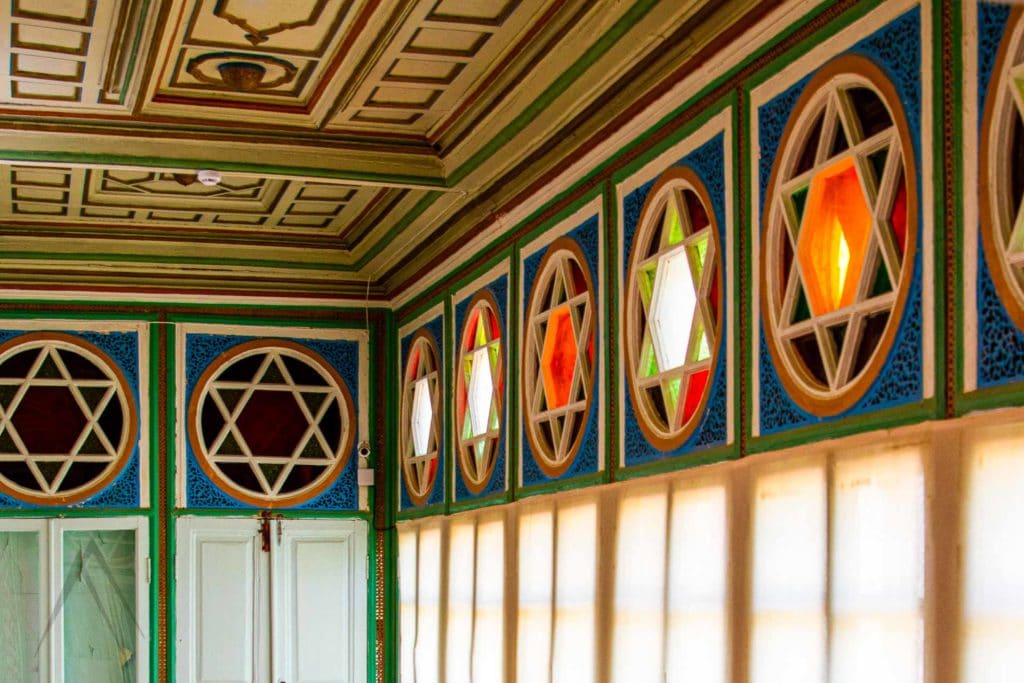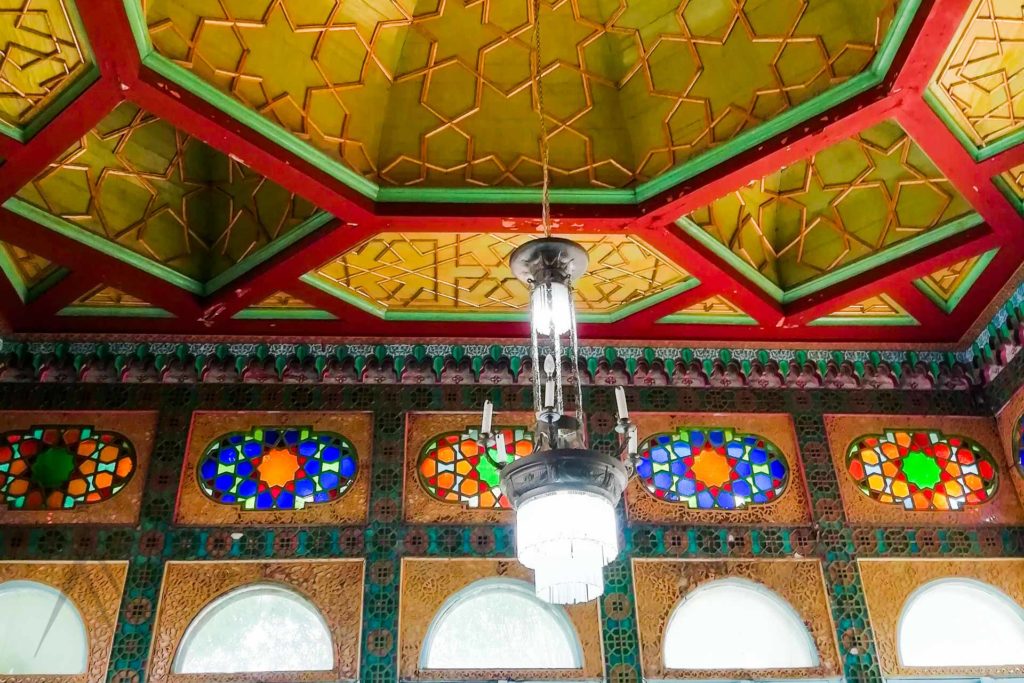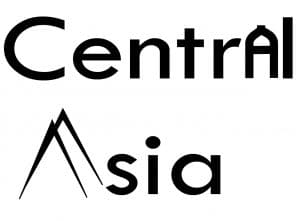Sitori Mokhi Khosa palace
Sitori Mokhi Khosa Palace
Sitori-i-Mokhi Khosa (or Sitorai) was the Summer Palace of the last emirs of Bukhara, located just 4 km north from the city center. It is a charming place that shows the luxurious lifestyle that the emirs were enjoying in their time. If you have seen any European historical palaces, you will most likely notice that there is something similar in this place but at the same time also something very Eastern oriental mixed with the European style. The story behind the strange familiarity is that the palace is one of the examples of the economic and cultural upsurge that took place in Uzbekistan in the late 19th and early 20th centuries which coincided with an increased interest in European art. Under this European influence, a new artistic style, blending Western and Eastern themes developed here, growing particularly prominent in the field of design and architecture.
According to a legend, the Emir requested the Aksakals (elderly wise men) to recommend a location for his summer residence. They told him to kill a lamb and separate it into four parts and to hang the pieces at the four corners outside the city. The piece that had been hung in the north was still fresh after some days and therefore this site was chosen as being the coolest area and at the same time not too far from the city.
History of Sitori Mokhi Khosa
The construction of the palace was initiated by the third-to-last Emir of Bukhara, Nasrullah Khan, in the 19th century. Nasrullah Khan was a mad and cruel khan, but he loved his wife sincerely. The palace was designed for the wife of the emir named Sitora-bony. Nasrullah Khan sent a delegation of Bukharan architects to St. Petersburg (which further explains the similarities) and to Yalta to get familiarized with new forms of architecture in order to implement it here.
As a result, the well-known Bukharan craftsmen and Russian engineers established the palace whose architecture, decor and layout harmoniously combine European tradition with the local inclination towards monumental and decorative art. Unluckily, the Khan’s wife died in childbirth but he still named the palace after her. He compared the beauty of her wife to the moon, therefore it became Sitora-i-Mokhi Khosa Saroy, the palace of a star like a moon.
In reality, nothing has remained of the original palace, but the name and the location. The palace we see today was built by Nasrullah’s son, the last Emir of Bukhara, named Alim Khan. The palace was finished in 1918 but he did not enjoy it for long as 3 years after it being finished, Bolshevik commander Mikhail Frunze led his army into the streets of Bukhara.
The Emir was chased away to Afganistan, while the soldiers had their reward, carrying off all 400 women in the Emir’s harem. This is how communism had arrived in Bukhara. Today, Sitorai Mokhi-Khosa Palace in Bukhara is a museum of decorative and applied arts where guests can become acquainted with the history of Bukhara and the life of the palace’s former royal inhabitants.


The Sitori Mokha Khosa Palace area
The palace area occupies about 7 hectares in total and all the buildings are surrounded by green gardens and courtyards. This garden-palace style was very common in the region and dates from the Timurids’ period. The palace has three courtyards: outside yard where men usually gather, middle yard for women and one for the harem. Every courtyard had its own gate and men never entered the women’s section and vice versa. From outside, the palace adopted a particularly Russian style but the insides of each room are decorated with striking, traditional Bukharan ornamentation and design.
The main hall is lit by a huge chandelier brought from Poland, the door locks and door handles were brought from England and most of the furniture was shipped from Russia in the 19th century. Venetian mirrors can be seen in the rooms and the tiles for fireplaces were brought from Germany. (The last emirs of Bukhara also graduated from the military academy in Saint Petersburg and were quite taken with European architecture and décor). Each room, including the Emir’s bedrooms, the white hall (reception room), the chess room, the waiting room and the emir’s tearoom have their unique design.
The summer tearoom (chaikhana) is another unique display of craftsmanship. Unlike other rooms of the palace, which are decorated with plant and floral patterns, the tearoom is adorned with multi-colored geometric designs and colored glass. Today the Emir’s glass-walled tearoom houses an exhibition of 19th – 20th-century porcelains, which Alim Khan keenly collected. His father, Emir Akhadkhan, was a passionate carpet collector and until the arrival of the Bolsheviks in Bukhara, it is believed that there were about 4000 carpets there, of which only few remain today.
The most famous room of Sitori i Mokhi Khosa is called “White Hall” and was constructed under the direction of renowned architect Shirin Muradov and his students. It a breathtaking room in which the walls are decorated with ganch (plaster). (In the Soviet period Muradov restored architectural monuments and carved decorations on many buildings in Tashkent. His most significant work was the carved ornamentation on the panels, ceilings, and cornices of the Bukhara Hall of Tashkent’s Opera House). Thirty craftsmen accomplished this room in two years, involving delicate ganch carvings, paintings and countless mirrors that created a unique effect reminding of a fairy tale world.
Between the middle courtyard and harem there is one more Russian-style building. It was a hotel for the Emir’s guests and today houses a small exhibition of 19th-century Bukharan clothing. Only two rooms can be seen with some partly original plaster decoration covered with gold leaf. According to historical information, Bukharan masters used about five kilos of gold to decorate the hotel’s interior. Prior to Uzbekistan’s’ independence in 1991, this building and the harem were part of a kidney sanatorium which is now relocated nearby.


Going further into the garden one finds a courtyard with a two-story building with a balcony and Russian style dome, a pond, a wooden pavilion and a minaret where the harem was located. The lower floof of the two-story building had the bedrooms for the Emir’s wives and upstairs housed the kitchen and a terrace where they had their breakfast and dinner plus a room for flowers. Today, the harem houses the Bukhara Museum of Applied Arts, where you can see outstanding examples of suzanis which are traditional hand embroided textiles hanged in the walls for decoration.
Travel to Sitori Mokhi Khosa
The palace is a great day trip from Bukhara if you need to take a break from the busy streets of Bukhara. Taxis can be ordered to take you here from any hotel and the palace can also be reached by public transportation and short walk.
